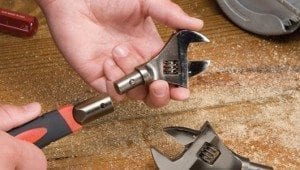
New features for hand tools make jobs go faster
 Since prehistoric times, our ability to solve problems has sparked useful tool innovations.
Since prehistoric times, our ability to solve problems has sparked useful tool innovations.
For example, work-related injuries caused by repetitive motion have inspired significant changes to the design and manufacture of hand tools. The results – texture-grip handles, swivel heads, lighter-weight materials – all these new features for hand tools to make them more comfortable, easier to use and more reliable.
Looking for ways to lighten the load in a contractor’s tool belt or other tool storage solutions, Glenn Robinson, president Iron Bridge Tools, took a practical approach. Instead of three separate tools, he designed interchangeable heads for one handle set. New in fall of 2007, the company’s Husky line of a pliers and wrenches use this concept.
The pliers set combines three contractor must-haves – lineman’s pliers, a diagonal cutter and needle-nose pliers – into a single tool. The triple-use tool features dual comfort-grip handles for ease of use and accessibility. The wrench set features a single cushion-grip handle that accommodates 6-, 8- and 10-inch adjustable heads.
Another of the new features for hand tools a pivoting head that indexes 180 degrees, solves the problem of fitting a tool into an awkward spot. Available for wrench or pliers sets, the tool head locks into seven different positions.
Pay for performance
But how do you know you’re getting a high-quality construction tool? Do you pick it up? Do you check the price? Do you ask a friend or co-worker? When it comes to buying hand tools, what matters are long-lasting materials, easier operation and better functionality.
Fred Leiva, owner of F&G, a Chicago-area remodeler, recommends strength and durability when his crew purchases new tools. “I have a pair of pliers that I bought 15 years ago,” Leiva says. “I still have them.”
“Time is money to contractors,” says Jeff Huebner, director of sales for Irwin Tools, makers of the Vise-Grip line. With that in mind, the company designed a new one-handed release button for its locking pliers. A bent-handle design on its slip-joint pliers delivers faster, smoother operation and prevents pinching.
Better tools are the result of today’s better manufacturing techniques and materials, says Scott Jonap, vice president of sales and marketing for Channellock. “New ways to heat treat with lasers make cutting edges and teeth last longer. Those are the things that give the user a better performing tool.”
Focus groups with users and research studies are two techniques Channellock uses to find out what’s important to contractors. “A pro is relying on tools to make their job easier,” Jonap adds. “The last thing they want is for a tool to break.”
Safe, smart tool usage
Unlike power tools, you supply the power when working with hand tools. But staying safe means working smart, so follow these tips:
-
Use each tool only for the job it was designed to do.
-
Avoid using extensions on tool handles for leverage.
-
Keep all tools clean and in working order. Discard damaged tools.
-
Shut off current before using a tool near electricity.
-
Wear safety goggles when using hand tools.
Source: The Hand Tools Institute.
Choose the right tool
Choosing the right tool for the task and one that fits your hand properly will reduce on-the-job injuries. These are the new features for hand tools that you need to look for before you buy a new plier or wrench.
| Tool | Attributes | Tasks | What to look for |
|---|---|---|---|
| Pliers – needle-nose, flat-nose, linesman, snap-ring, locking-jaw, groove-joint, etc. | Double handles measured by handle length and grip span | Used for power tasks such as cutting, bending, pinching, gripping | Spring-loaded, soft-coated handles. Grip span of at least 2" when fully closed, no more than 3½" when fully open, no sharp edges or finger grooves |
| Wrenches – hand, pipe, monkey, T- handle, impact, socket, lug, etc. | Single handles measured by handle length and diameter | Used for driving tasks, such as turning or pushing, that require torque | Handle length between 4" and 6". JHandle diameter from 1¼" to 2". Non-slip handle grip surface |
Source: National Institute for Occupational Safety and Health.

